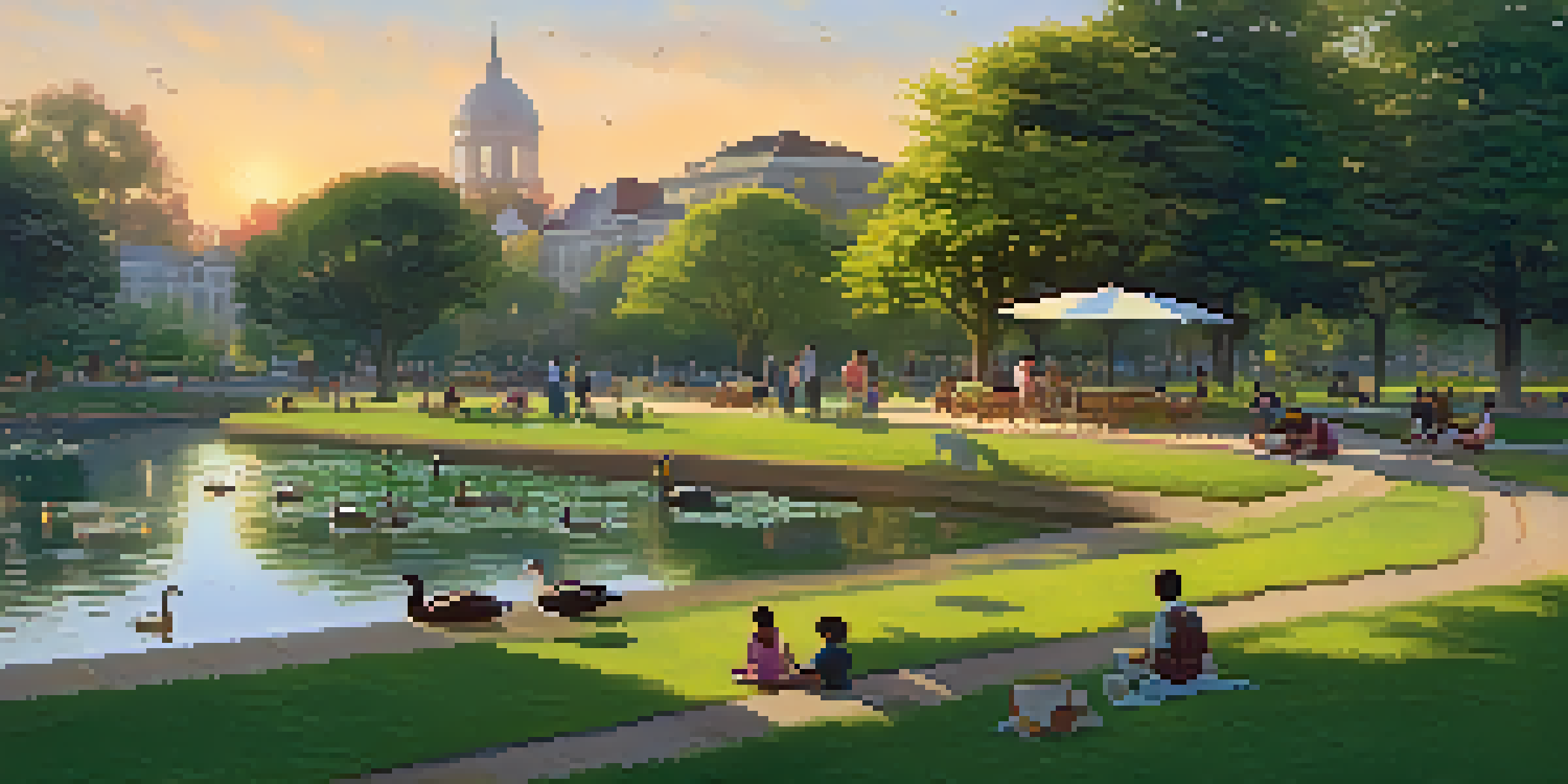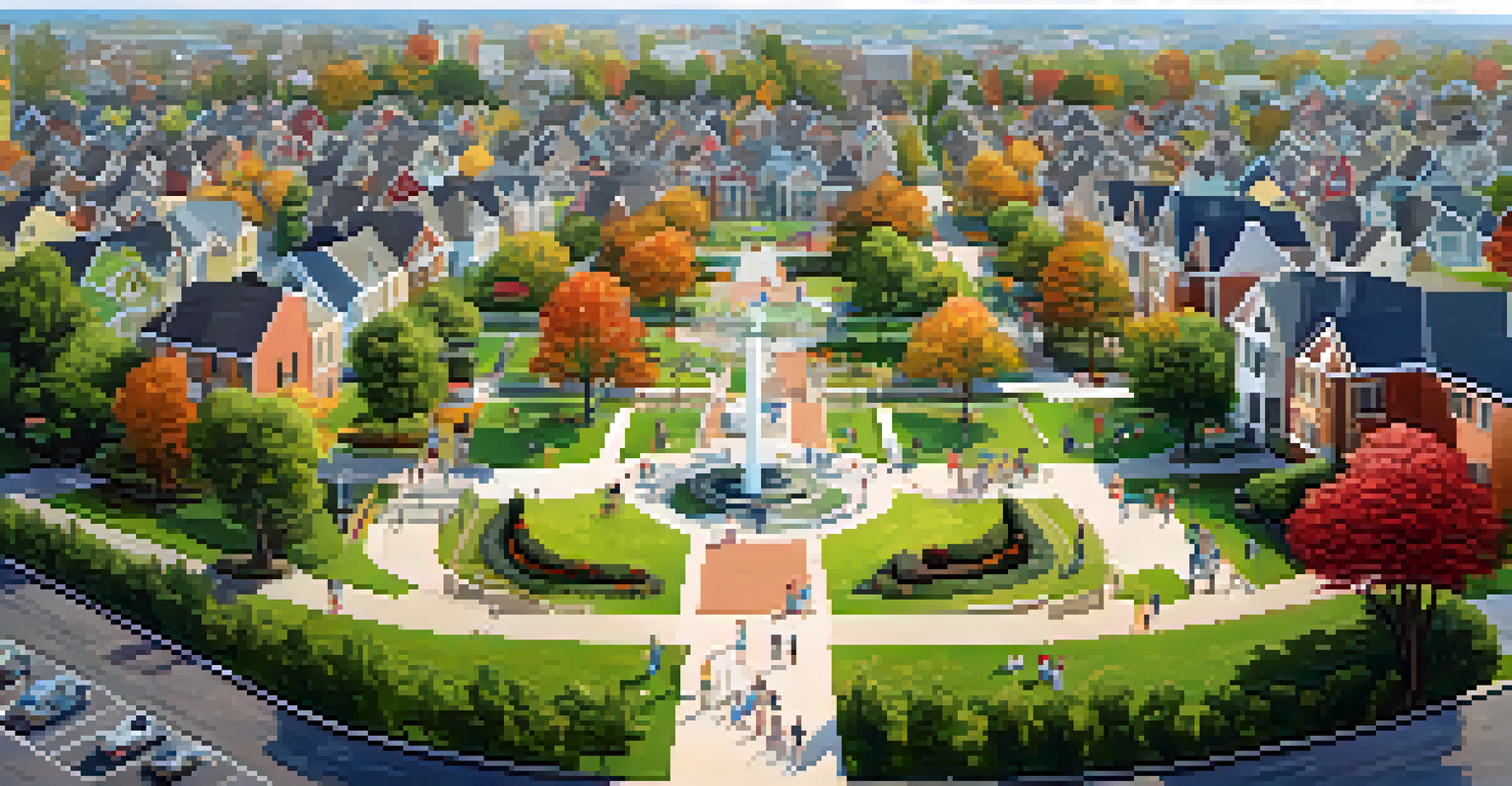The Role of Parks in Enhancing Property Values in Neighborhoods

The Connection Between Parks and Property Values
Parks play a crucial role in determining the value of properties in a neighborhood. A well-maintained park can serve as a community centerpiece, attracting families and individuals looking for a vibrant living environment. Studies consistently show that homes located near parks tend to have higher market values compared to those farther away.
Parks are not just parks; they are the lungs of our cities.
This connection is often rooted in the idea that proximity to green spaces provides not just aesthetic benefits, but also practical ones. People are drawn to areas where they can enjoy outdoor activities, which enhances their quality of life. Consequently, homes near parks are often viewed as more desirable, driving up their prices.
Moreover, the presence of parks can lead to increased demand for housing in the area, further boosting property values. In essence, parks serve as a silent yet powerful influencer in the real estate market, shaping the perceptions of potential buyers and making neighborhoods more attractive.
Psychological Benefits of Living Near Parks
Living near parks offers psychological benefits that contribute to property values. Green spaces often provide a sense of tranquility and escape from urban hustle, making them appealing to homebuyers. When people envision a peaceful lifestyle, parks become a crucial part of that picture.

Additionally, access to parks encourages physical activity, which is linked to improved mental health. Families with children, in particular, appreciate the opportunity for outdoor play and socialization, making neighborhoods with parks more appealing. This creates a positive feedback loop where the demand for homes increases, thus raising property values.
Parks Boost Property Values
Proximity to well-maintained parks increases the market value of nearby homes, making them more desirable to buyers.
The psychological allure of parks can also enhance community cohesion. Neighbors are more likely to interact and form connections in shared green spaces, fostering a sense of belonging. This communal spirit not only lifts property values but also enriches the overall living experience.
Economic Advantages of Nearby Parks
From an economic perspective, parks can significantly contribute to local property values. They attract not only residents but also businesses looking for a vibrant community atmosphere. When parks are nearby, the likelihood of foot traffic increases, which is beneficial for local shops and services.
The best way to predict the future is to create it.
Moreover, parks often host events and activities that bring the community together, further stimulating the local economy. Increased activity can lead to higher sales for nearby businesses, which can indirectly boost property values as the area becomes more sought after. This creates a win-win situation for both homeowners and local entrepreneurs.
Additionally, municipalities often invest in maintaining and improving parks, which can further enhance property values. These investments signal to potential buyers that the neighborhood is well-cared for, making it a desirable place to live. Thus, parks serve as a catalyst for economic growth and community development.
Parks as Community Gathering Spaces
Parks serve as essential gathering spaces for communities, helping to foster social interactions and relationships among residents. Whether it's a weekend picnic, a farmers' market, or a summer concert, these events bring people together and create a shared sense of identity. This sense of community can make a neighborhood more appealing to potential buyers.
When neighborhoods have vibrant parks, they often become focal points for local culture and activities. The more active and engaging a park is, the more it enhances the neighborhood's overall appeal. As such, homes near these parks are often viewed as prime real estate, which can lead to increased property values.
Psychological and Community Benefits
Living near parks provides psychological advantages and fosters community engagement, further enhancing property appeal.
Additionally, parks can host programs that cater to various demographics, from children's sports leagues to yoga classes for adults. This diversity in activities not only enriches community life but also makes the area more attractive to prospective homeowners, further contributing to the rise in property values.
Environmental Benefits of Parks That Affect Property Values
Parks offer several environmental benefits that enhance property values, including improved air quality and biodiversity. The presence of trees and green spaces can significantly reduce pollution levels, creating a healthier living environment. Homebuyers are increasingly aware of these benefits, making homes near parks more desirable.
Moreover, parks contribute to effective stormwater management, reducing flooding risks in surrounding neighborhoods. This practical benefit can lead to lower insurance costs for homeowners, making properties in park-adjacent areas more appealing. Buyers often factor in these environmental advantages when considering a home purchase.
Additionally, parks help promote wildlife habitats, which can enhance the beauty and serenity of a neighborhood. The presence of birds and other wildlife can create a more enjoyable living experience, ultimately affecting property values positively. Thus, the environmental benefits of parks play a significant role in shaping real estate markets.
The Long-Term Impact of Parks on Neighborhood Development
The long-term impact of parks on neighborhood development cannot be overstated. Over time, as communities continue to grow and evolve, parks remain a central feature that attracts residents. This sustained interest can lead to increased investment in the area, further boosting property values.
As neighborhoods develop around parks, there is often a push for additional amenities and services, such as cafes, bike paths, and enhanced recreational facilities. These improvements not only increase the quality of life for residents but also attract more homebuyers, driving property values higher.
Economic Growth Through Parks
Parks attract businesses and stimulate local economies, contributing to increased property values in surrounding areas.
Ultimately, the integration of parks into neighborhood planning is a strategic investment in the community's future. A well-designed park can be a catalyst for sustainable growth, making the area more attractive for years to come. This long-term vision ensures that properties near parks remain valuable and sought after.
Case Studies: Successful Neighborhoods with Parks
Several neighborhoods have successfully demonstrated the positive impact of parks on property values. For example, the revitalization of Central Park in New York City not only transformed the park itself but also significantly boosted surrounding property values. Homebuyers are willing to pay a premium for homes near such iconic green spaces.
Similarly, the development of neighborhood parks in urban areas across the United States has shown a direct correlation between park quality and increased property values. Areas that prioritize green spaces often see a surge in interest from potential buyers, leading to higher sales prices and rental rates.

These case studies highlight the importance of parks in real estate dynamics. They serve as powerful examples of how investing in parks can lead to thriving communities and increased property values, making them essential components of urban planning.
Conclusion: Parks as Key Drivers of Property Value
In conclusion, parks are much more than just patches of greenery; they are vital assets that enhance property values in neighborhoods. From psychological benefits to economic advantages, parks contribute significantly to the desirability of a community. As homebuyers increasingly seek environments that promote well-being, the value of living near parks continues to rise.
The long-term impact of parks on neighborhood development further solidifies their importance in real estate. As cities grow, the integration of parks into planning ensures that communities remain vibrant and attractive. This means that both current residents and prospective buyers should appreciate the value parks bring to their neighborhoods.
Ultimately, recognizing the role of parks in enhancing property values can lead to more informed decisions for homeowners, investors, and city planners alike. By prioritizing green spaces, we can create thriving communities that stand the test of time.